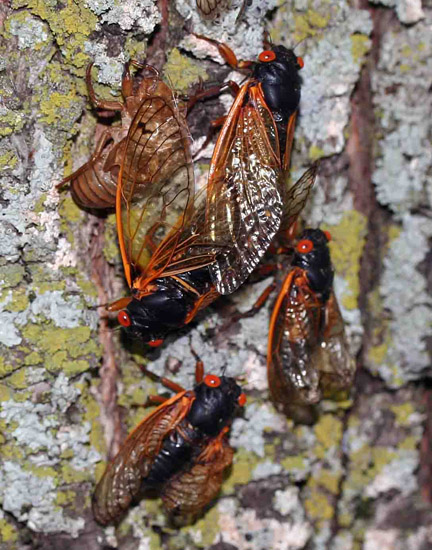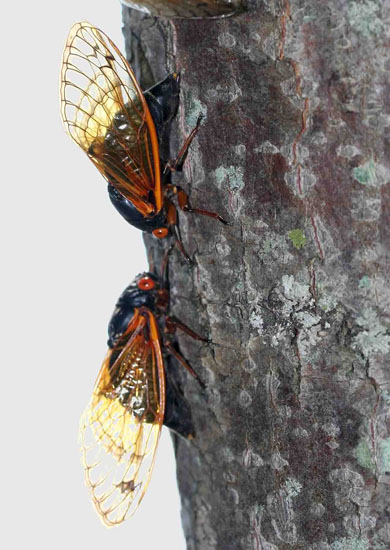Issue 8, June 13, 2011
Periodical Cicada
Large numbers of periodical cicadas were observed to be dead and dying in the Decatur area on June 9. There was still a large amount of male singing and mating was still occurring, but females were also starting to lay eggs. If you have not yet provided protection to young trees, it is time to do so.
Male cicadas die before the females. After the males die, egg-laying by the females occurs in earnest. A reduction in singing by the males makes it easy to notice when this change in behavior occurs.

Periodical cicadas are also subject to a white fungus that covers the abdomen when it is sporulating. The abdomen becomes brittle and can easily break off, releasing a cloud of white spores. Prior to sporulation, the abdomen appears greenish. This fungus appears to cause high mortality in some emergences. The cicadas observed near Decatur and on May 29 in Douglas County did not exhibit indications of high fungus infestation. We have not received any other reports of its high incidence this year either.
Although periodical cicadas primarily insert eggs into twigs less than one-fourth inch in diameter, sufficient numbers can be laid in the trunks of trees less than two inches in diameter to weaken the trunks enough for them to snap off in heavy winds. The smaller the diameter of the trunks and the higher the number of cicadas, the more likely it is that this will happen. Commercial fruit tree growers commonly plant slender whips that are very susceptible to periodical cicada damage. In the past, Illinois fruit growers have lost up to 90% of their trees in new plantings due to cicada egg-laying damage.

Carbaryl (Sevin) and several pyrethroid sprays kill many cicadas, causing the ground to be littered with dead bodies. However, research tests in ornamental tree nurseries have revealed little reduction in ovipositional damage even though many cicada adults were killed prior to egg-laying. In comparison, fruit tree growers using the same and similar insecticides obtain enough of a reduction in ovipositional damage to allow most trees to survive. Perhaps the difference is that landscape nurseries generally have larger trees that are unlikely to be killed, although they sustain severe aesthetic trunk injury that reduces salability.. There is little concern about aesthetic damage to fruit tree plantings, but the trees are smaller, resulting in higher tree mortality without a reduction in cicada oviposition.
Individual trees can be protected by wrapping hardware cloth around the trunk from the ground to the first scaffold branches or higher. The wrap should stand off from the trunk to keep cicadas from attacking through the screening. The wire thickness and resulting stiffness of hardware cloth makes this relatively easy. Be sure to secure the wrap securely at the base of the tree as cicadas commonly drop to the ground and then walk up tree trunks. Also secure tightly the top of the screening to exclude cicadas from walking down the trunk.
This method of protection is more practical in landscapes than in nurseries where the number of trees can be overwhelming and costly. Protection from ovipositional damage has been achieved in the past with plastic and even paper tree wraps, but those risk increases in borer and disease problems when used during the growing season. (Phil Nixon)
Author:
Phil Nixon